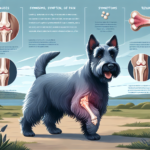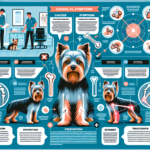Scottish Terrier Joint Pain: Causes, Symptoms, Prevention, and Treatment

Introduction
Overview of Scottish Terrier: The Scottish Terrier, affectionately known as the “Scottie,” is a small, sturdy breed with a rich history dating back to the 17th century in Scotland. Originally bred for hunting and vermin control, Scotties are known for their distinctive appearance, characterized by a wiry coat, bushy eyebrows, and a dignified beard. They are loyal, independent, and spirited, making them beloved companions and show dogs.
General Health Concerns: Like many purebred dogs, Scottish Terriers are prone to certain health issues. Common concerns include skin allergies, bladder cancer, and genetic disorders. Among these, joint pain is a significant issue that can affect their quality of life.
Importance of Joint Health in Scottish Terriers: Joint health is crucial for Scottish Terriers due to their active nature and compact build. Healthy joints ensure they can maintain their mobility and enjoy a good quality of life. Neglecting joint health can lead to chronic pain, reduced activity, and a diminished lifespan.
Breed-Specific Joint Pain Risks
Genetic Predisposition
Scottish Terriers have a genetic predisposition to several joint-related issues. Hip dysplasia, a condition where the hip joint doesn’t fit properly into the hip socket, is relatively common. Arthritis, an inflammation of the joints, can also develop as they age. Elbow dysplasia, although less common, can still occur and cause significant discomfort.
Age-Related Risks
As Scottish Terriers age, the risk of joint pain increases. Typically, signs of joint issues may start appearing around middle age, which for Scotties is around 5-7 years. Senior Scotties, those over 8 years old, are particularly susceptible to arthritis and other degenerative joint conditions.
Activity Level and Joint Stress
Scottish Terriers are known for their high energy levels and love for play. While regular exercise is essential for their overall health, excessive or inappropriate activity can put undue stress on their joints. Activities like jumping from heights or running on hard surfaces can exacerbate joint issues.
Common Symptoms of Joint Pain in Scottish Terriers
General Symptoms
- Limping: One of the most noticeable signs of joint pain is limping or favoring one leg over another.
- Stiffness: Stiffness, especially after rest or sleep, can indicate joint discomfort.
- Reluctance to Move: A dog that is hesitant to climb stairs, jump, or even walk may be experiencing joint pain.
- Swelling: Visible swelling around the joints can be a sign of inflammation.
- Behavioral Changes: Increased irritability or changes in behavior can also be indicative of pain.
Breed-Specific Symptoms
In Scottish Terriers, joint pain may manifest as a reluctance to engage in their usual playful activities. They may also show signs of discomfort when being picked up or handled, particularly around the hindquarters.
When to Consult a Vet
If you notice any of the above symptoms, it’s crucial to consult a veterinarian. Early intervention can prevent further deterioration and improve your dog’s quality of life. Persistent limping, noticeable pain, or any sudden changes in behavior should prompt an immediate vet visit.
Preventive Measures for Joint Health
Exercise Recommendations
Regular, moderate exercise is key to maintaining joint health in Scottish Terriers. Activities like walking, swimming, and gentle play are ideal. Avoid high-impact exercises like jumping or running on hard surfaces. Consistent, low-impact exercise helps keep the joints flexible and muscles strong.
Dietary Suggestions
A balanced diet rich in essential nutrients supports joint health. Foods high in omega-3 fatty acids, such as fish oil, can reduce inflammation. Supplements like glucosamine and chondroitin can also promote joint health. Always consult your vet before adding supplements to your dog’s diet.
Weight Management
Maintaining a healthy weight is crucial for reducing joint stress. Overweight dogs are more prone to joint issues due to the extra load on their joints. Regular exercise and a balanced diet can help keep your Scottish Terrier at an optimal weight.
Early Screening and Monitoring
Regular veterinary check-ups are essential for early detection of joint issues. Screening tests like X-rays can identify problems before they become severe. Monitoring your dog’s movement and behavior can also help catch early signs of joint pain.
Treatment Options for Joint Pain
Non-Surgical Treatments
Non-surgical treatments are often the first line of defense against joint pain. These include:
- Medications: Anti-inflammatory drugs and pain relievers can help manage symptoms.
- Physical Therapy: Exercises and treatments designed to improve joint function and reduce pain.
- Lifestyle Adjustments: Modifying activities to reduce joint stress and incorporating joint-friendly exercises.
Surgical Options
In severe cases, surgical intervention may be necessary. Common surgeries for joint issues include:
- Hip Replacement: Replacing a damaged hip joint with an artificial one.
- Arthroscopy: A minimally invasive surgery to remove damaged tissue or repair joints.
- Joint Fusion: Fusing bones together to stabilize a joint and reduce pain.
Alternative Therapies
Alternative treatments can complement traditional methods. These include:
- Acupuncture: Using needles to stimulate specific points on the body to relieve pain.
- Hydrotherapy: Water-based exercises that reduce joint stress while improving mobility.
- Massage: Therapeutic massage can help reduce muscle tension and improve circulation.
Lifestyle and Management Tips
Daily Care Routine
A consistent daily care routine can help manage joint pain. This might include:
- Regular, gentle exercise like walking or swimming.
- A balanced diet with joint-supporting supplements.
- Administering prescribed medications or treatments.
- Monitoring your dog’s behavior and mobility for any changes.
Modifying the Home Environment
Making your home more comfortable for a dog with joint pain can significantly improve their quality of life. Consider:
- Installing ramps to help them navigate stairs.
- Providing orthopedic beds for better joint support.
- Ensuring food and water bowls are at a comfortable height.
Long-Term Management
Long-term management strategies include regular vet check-ups, maintaining a healthy weight, and continuing with appropriate exercise and diet. Consistency is key to keeping your Scottish Terrier active and happy despite joint pain.
FAQs About Scottish Terriers and Joint Pain
What are the early signs of joint pain in Scottish Terriers?
Early signs include limping, stiffness, reluctance to move, and behavioral changes. If you notice any of these symptoms, consult your vet.
Can joint pain in Scottish Terriers be prevented?
While you can’t entirely prevent genetic predispositions, maintaining a healthy weight, providing appropriate exercise, and regular vet check-ups can significantly reduce the risk.
Are there specific foods that can help with joint health?
Yes, foods rich in omega-3 fatty acids and supplements like glucosamine and chondroitin can support joint health. Always consult your vet before making dietary changes.
When should I consider surgery for my dog’s joint pain?
Surgery is usually considered when non-surgical treatments are ineffective, and the dog’s quality of life is significantly affected. Your vet will guide you through the options based on your dog’s condition.
Conclusion
Joint pain is a common issue in Scottish Terriers, but with proper care and attention, it can be managed effectively. Regular exercise, a balanced diet, weight management, and early detection are crucial for maintaining joint health. Always consult your veterinarian for personalized advice and treatment options. By taking proactive measures, you can ensure your Scottish Terrier enjoys a happy, active life.

